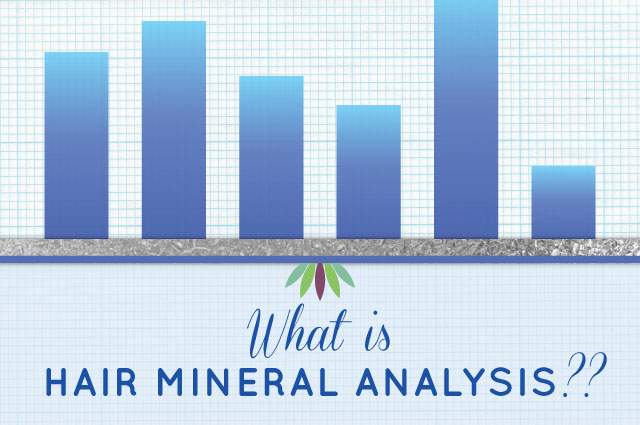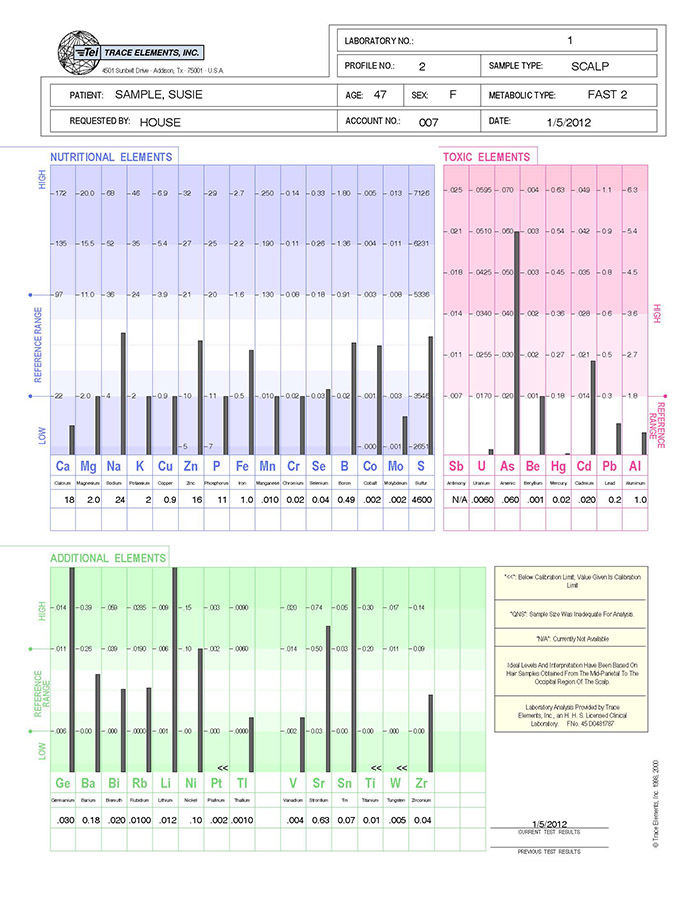A hair mineral analysis reveals your mineral deficiencies and heavy metal toxicity.
The hair is tested because it is one of many places the body dumps excess minerals and heavy metals for storage away from vital organs. The amounts of minerals deposited in the hair reveal all kinds of things about your body chemistry. Your test results reveal and explain the causes of many health symptoms and disease, whose underlying causes are almost always related to nutritional deficiencies, mineral imbalances and heavy metal toxicity.
Why test the hair?
- Sampling is simple and non-invasive.
- Since hair is a stable material that requires no special handling, samples may be sent via standard mail, therefore allowing hair analysis to be performed entirely from the comfort of one’s own home.
- It’s cost-effective!
What Is Tested on a Hair Mineral Analysis?
A hair tissue mineral analysis tests for 37 nutritive minerals and toxic metals. It is a screening test that measures the mineral content of your hair. Mineral content of your hair reflects the mineral content of the body’s tissues. If a mineral deficiency or excess exists in the hair, it usually indicates a mineral imbalance within the body, or bio-unavailability of that mineral.
The hair is tested because it is one of many places the body dumps excess minerals and heavy metals for storage away from vital organs. The amounts of minerals deposited in the hair reveal all kinds of things about your body chemistry. A hair mineral analysis is the basis upon which a customized Myers Detox Protocol program is designed.
Your hair sample is simply cut at the scalp by your practitioner or a friend. You need about 1.1 grams of hair to do the test. One inch (2.2cm) of hair will show what is being dumped into the hair over a three month period.
Will my first test show all my Heavy Metal toxicities?
Your toxicity level will not completely show or show at all on your first test. If you’ve done a test with Analytical Research Labs (ARL), Trace Elements (TEI) or another company or your doctor, please be aware that a glowing first test means nothing – heavy metals stored in your tissues like the bones, brains and organs will not all show on the test.
Acute metal poisoning is rare. More common, however, is a chronic, low-level exposure to toxic metals that can result in significant retention in the body that can be associated with a vast array of adverse health effects and chronic disease.
Many people are very ill by the time they do a hair test and their bodies do not have the energy or are too sick to detox any longer. Most metals are what we call “hidden,” which means that the toxic metals don’t show up in the hair even though they are in other parts of the body. These toxins build up in the fat cells, liver, kidneys and other areas of the body. In many people, their bodies are too tired and malnourished to get rid of these toxins, so they stay “hidden” in these tissues.
When the body gets stronger, it will start pushing them out and removing them. When it does this, some of them will be put into the hair and we will see them on future hair tests. You may ask, “How do you know everyone has toxic metals?” This knowledge comes from years of experience with these hair tests. Also, everyone gets exposed to various toxic metals. If the body has enough energy to get rid of it on a continual basis, the level is higher on the hair test. A very low level means that one can’t get rid of it, and it is accumulating inside one’s body.
Heavy metals must actively be purged for years and will only reveal themselves on subsequent hair tests as they are removed from the tissues and flushed out of the body. This requires a comprehensive program provided by Myers Detox Protocol that combines the right diet, supplements, lifestyle and detox protocols that allow detoxification of these heavy metals on the deepest level.
What does a Hair Mineral Analysis reveal?
Hair mineral analyses are not medical tests. They are screening tests only and do not diagnose disease. However, a properly performed and interpreted hair analysis can reveal various mineral imbalances that indicate a tendency for various conditions. All of the mineral levels as a whole give a trained and experienced practitioner an idea of the condition of the various organs and the body as a whole.
Conditions which may result or be aggravated by a mineral imbalance are:
Depression, Hypoglycemia, Hyperactivity, Headaches, Hypertension, Arthritis, Hair Loss, Anemia, Thyroid Disturbance, Prostate Disorders, Digestive Disturbance, Diabetes, Musculo-Skeletal Disorders, Cardiovascular Disease, Skin Rashes, Emotional Problems, Allergies, and More.
Is Hair Mineral Analysis accurate?
Like any test, no test is 100% accurate. Hair mineral analysis is not always 100% accurate. Of course, if the client does not follow hair sampling instructions correctly, the results can be skewed, for instance if they use a dandruff shampoo with zinc. But the test is accurate enough for the purposes of telling something what supplements they should be taking and what heavy metals they are dumping into the hair.
The accuracy of the test also depends upon which lab it is sent to. Just like medical tests, there are great testing companies like Metametrix and companies that do a really poor job.
At Myers Detox, we run all our tests through the laboratory Trace Elements, Inc (TEI). This internationally-recognized lab that is a world leader in HTMA laboratory services. Its founder, Dr. David Watts, is a pioneer in hair tissue mineral analysis. TEI has run more than 100,000 tests, and they process hair samples without washing them, which sets them apart from many other labs (washing a sample removes minerals, which leads to inaccurate results for proper interpretation).
In short, TEI is the gold standard for hair analysis. You can rest assured that your results with be accurate.
The key issue and debate surrounding hair testing and whether it’s accurate really is simply about whether the hair is washed or not. The detractors are not really making this distinction. There have been a couple studies as to the efficacy of hair testing, but they were all washing the hair so of course the testing was not accurate. These studies were simply designed poorly. The test is not going to be accurate if you wash the hair with harsh solvents, which is what most companies do. This washes away the water-soluble minerals like sodium and potassium that are critical in determining thyroid and adrenal function.
There are only two companies in the US that don’t wash the hair – ARL and TEI. They don’t wash the hair so we get an accurate result. It’s one of those issues where all companies that do hair mineral analyses cannot be compared. You cannot say all hair mineral analyses are a waste of time or money. This statement is accurate for most companies that perform this test. There are distinctions that many physicians and other health practitioners are not making when advising clients to avoid them. I ran into this myself when I was asking around about whether I should do it prior to my first hair test. Everyone, including my ND, told me it wasn’t accurate and to not bother. But I tried it anyways because I was curious. I’m glad I did!
If you want to get properly tested for heavy metals and find out EXACTLY which metals you are being exposed to — this is the test I recommend.
Who Needs a Hair Analysis?
Everyone should be tested to see what issues are going on in the body to which they may be unaware. Hair analysis can be used as a preventative tool by revealing mineral imbalances even before any health ailments become manifest. Hair analysis opens up a whole new vista for solving health ailments by recognizing your biochemical individuality.
If you’re not sure which metals are affecting you – whether it is thallium or countless others – a hair mineral analysis (HTMA) can give you the answers you’re searching for.
It’s the missing piece of the puzzle. Here’s why an HTMA is absolutely essential:
Unless you address the FULL SPECTRUM of toxic heavy metals that are harming your body right now…
… you will never have the health, energy, weight, or beauty you deserve.
You likely are facing daily exposure to a whole laundry list of heavy metal pollutants.
Each metal only responds to specific nutrients and detox solutions — so without HTMA testing, you could be taking the wrong supplements for the metals that you have!
Why Test for Minerals?
Minerals are the “sparkplugs” of life. They are involved in almost all enzyme reactions in the body. Without enzyme activity, life does not exist.
The hair analysis graph shows the following nutrient minerals: calcium, magnesium, sodium, potassium, iron, copper, manganese, zinc, chromium, selenium, and phosphorus. These minerals are necessary for proper functions of the organs and tissues of the body, but can also metastasize (store in organs where they’re not supposed to be) and prevent proper function in an unhealthy body. The hair analysis also shows toxic minerals like lead, mercury, cadmium, arsenic and aluminum, as well as other minerals like nickel, cobalt, molybdenum, lithium and boron.
Common Causes of Mineral Imbalances
- Exposure to toxic metals from the air, food, water, environment, job or hobby.
- Improper diet such as excessive intake of refined carbohydrates and sugars, strict vegetarian and vegan diets or other nutrient deficient diets.
- Inheritance of mineral patterns from parents. Mothers pass their mineral deficiencies and excesses to their children.
- Taking vitamins and minerals that are not compatible with your current body chemistry.
- Medications
- Birth Control Pills
- Stress depletes minerals
Is heavy metal toxicity a cause of my health ailments?
Hair mineral analysis screens for toxic metals including lead, mercury, cadmium, arsenic, aluminum and nickel. Presently, humanity is exposed to the highest levels of toxic metals in recorded history, up to several thousand times higher than even several hundred years ago due to industrialization.
Many health conditions are simply heavy metal toxicity and can contribute to any imaginable health ailment or condition including cases of diabetes, cancer, multiple sclerosis, Parkinson’s disease, and others.
The danger of toxic metals in our environment is greatly aggravated due to low mineral content of our food supply and contamination of our food supply. If one does not consume preferred minerals in the diet, the body will pick up whatever toxic metals from the food, air, and water as substitutes. A key principle to remember is an abundance of essential minerals in the diet protects the body against toxic metals.
What are common toxicities found on hair tests?
Copper toxicity is one of the most commonly encountered imbalances that we find on hair tests and is a contributor to many health problems including anorexia, fatigue, premenstrual syndrome, depression, anxiety, migraine headaches, allergies, childhood hyperactivity and learning disorders.
Mercury is found in almost everyone from consuming fish, although it’s also in the air due to coal burning. Mercury toxicity is associated with countless health issues including adrenal gland dysfunction, thyroid dysfunction, alopecia, bipolar disorder, birth defects, blushing, depression, dermatitis, dizziness, fatigue, headaches, hearing loss, hyperactivity, immune system dysfunction, insomnia, kidney damage, memory loss, mood swings, nervousness, numbness and tingling, pain in limbs, schizophrenia, tremors, peripheral vision loss and muscle weakness.
Aluminum is the most common element of the earth’s crust and is a very common toxicity. Aluminum has been found to be associated with Alzheimer’s disease, anemia and other blood disorders, colic, fatigue, dental caries, dementia dialactica, hypoparathyroidism, kidney and liver dysfunctions, neuromuscular disorders, osteomalacia and Parkinson’s disease.
Iron toxicity is typically due to overconsumption of grain and protein powder products that are “fortified”, but with a toxic form of iron. Iron toxicity is associated with inflammation, diabetes, hypoglycemia, prostate disorders, cancers, feelings of anger and rage, and infections.
Hair Mineral Analysis vs. Urine Testing
In a urine metals analysis one compares the levels of metals in urine before and after the administration of a pharmaceutical metal detoxification agent such as EDTA, DMSA or DMPS. Urine metals push tests using EDTA, DMSA or DMPS are perfectly good tests to show heavy metals in the body. Like any metals test, they will not show all your heavy metals. Most of our heavy metals are buried deep in our bones, brains and tissues and will only be revealed on any test after being on a detox program for an extended period of time.
These push tests are great adjuncts to HTMA because they show metals that are not on an HTMA and they use chelators to reveal metals that typically don’t show on an HTMA like lead.
Hair Mineral Analysis vs. Blood Testing
I don’t find blood to be an accurate indicator of metal status in the body. This is why so many people get tests and show low or no levels of metals. This tests gives many physicians a false sense of toxicity and they then miss vital information underlying a patients health issues.
The blood is generally maintained at the expense of other tissues such as the hair. The blood is the life force of the body and must be kept at very precise mineral levels – homeostasis. Mineral levels are kept relatively constant in the blood even when pathology is present (often at the expense of other tissues) and therefore the blood does not always accurately reflect existing mineral deficiencies and excesses. By the time mineral levels are low in the blood, the person is usually very ill.
This means that if there are any mineral imbalances in the body, they will show up first in the tissues such as the hair often years before the blood. For instance, if you have a zinc deficiency, it will show up far sooner in the hair because the body will literally reroute zinc from the less important tissues such as the hair to maintain the level in the blood and other vital organs.
Therefore, analysis of the mineral content of an individual’s hair can provide us with a general ‘blueprint’ of the mineral content in the rest of the body’s tissues. Since these minerals are crucial to the functioning of enzymes, hormones and other biochemical systems that sustain life, it is possible to read this ‘blueprint’ and see where metabolic patterns are deviating from the norm.
Toxic metals are not found in high concentrations in the blood except 90 days or less after an acute exposure. The body quickly shunts toxic metals into the tissues such as the hair, where they do much less damage. Since the body shunts heavy metals out of blood and into storage quickly, blood serum is not a good place to locate toxic metals unless the exposure took place in the past 1-3 months.
Metals are far easier to detect and measure accurately in the hair. Blood tests can vary significantly from hour to hour depending upon one’s diet, activity level, the time of day and many other factors. One benefit of hair analysis is the readings are not affected by day-to-day ups and downs of dietary changes such as the last meal you ate, menstrual cycles, and other short-term factors. Hair tests show a three month average of what has been dumped into the hair.
Get a Hair Mineral Analysis
If you’re interested in getting a hair mineral analysis simply click here. With this test you can begin your healing journey.
A hair mineral analysis shows your mineral levels and toxic heavy metal levels – or at least which are being currently dumped, or eliminated, into the hair. Additionally, it reveals your stress pattern – or how your adrenals and thyroid are functioning.
Your HTMA will show you everything you need to guide you towards better health and wellness.
Takeaway
EVERYONE has heavy metal toxicity. The only point of testing is so that your health practitioner can give you a plan to remove your heavy metals and replace the minerals in which you’re found to be deficient. In the absence of an effective plan to remove your heavy metals, you are only receiving a test that provides obvious information – that you have heavy metal toxicities.
I implore you to start thinking about your health and working to improve your health before you get sick. A hair mineral analysis can give you a crystal ball and preview into your state of health because it shows health issues and body chemistry imbalances before you manifest symptoms.
You are likely facing daily exposure to a whole laundry list of heavy metal pollutants.
The information revealed in an HTMA is crucial because, once you have pinpointed which pollutants are in your system, you can take actionable steps to:
- Support the body’s natural excretion of these pollutants from your system
- Shield yourself from further exposure to sources of these toxic health hazards
- Detox from everyday living
- Support and maintain a clean and healthy lifestyle
Take action to protect your health today. Learn more about HTMA here.
*Please note that A Hair Mineral Analysis (HTMA) is not intended to diagnose, treat, cure, reverse, or prevent any disease. It is not intended to replace any other medical test(s) that may be prescribed by your medical doctor.










